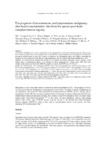Mostrar o rexistro simple do ítem
The prognosis of noncutaneous, nonlymphomatous malignancy after heart transplantation: data from the spanish post-heart transplant tumour registry
| dc.contributor.author | Crespo-Leiro, María Generosa | |
| dc.contributor.author | Alonso-Pulpón, Luis | |
| dc.contributor.author | Villa-Arranz, Adolfo | |
| dc.contributor.author | Brossa-Loidi, Vicens | |
| dc.contributor.author | Almenar-Bonet, Luis | |
| dc.contributor.author | González-Vílchez, Francisco | |
| dc.contributor.author | Delgado-Jiménez, Juan F. | |
| dc.contributor.author | Manito-Lorite, Nicolás | |
| dc.contributor.author | Díaz Molina, Beatriz | |
| dc.contributor.author | Rábago, Gregorio | |
| dc.contributor.author | Arizón-del-Prado, José M. | |
| dc.contributor.author | Romero-Rodríguez, N. | |
| dc.contributor.author | Brossa, V. | |
| dc.contributor.author | Blasco-Peiró, Teresa | |
| dc.contributor.author | Pascual Figal, Domingo A. | |
| dc.contributor.author | De la Fuente-Galán, Luis | |
| dc.contributor.author | Muñiz, Javier | |
| dc.date.accessioned | 2015-09-16T11:50:20Z | |
| dc.date.available | 2015-09-16T11:50:20Z | |
| dc.date.issued | 2010-10-21 | |
| dc.identifier.citation | Crespo-Leiro MG, Alonso-Pulpón LA, Vila-Arranz A, Brossa-Loidi V, Almenar-Bonet L, González-Vílchez F, et al. The prognosis of noncutaneous, nonlymphomatous malignancy after heart transplantation: data from the spanish post-heart transplant tumour registry. Transplant Proc. 2010;42(8):3011-3013 | es_ES |
| dc.identifier.uri | http://hdl.handle.net/2183/14937 | |
| dc.description.abstract | [Abstract] Introduction. Malignancy is a major complication in the management of solid organ transplant patients. Skin cancers show a better prognosis than other neoplasms, but not all others are equal: Ideally, patient management must take into account the natural history of each type of cancer in relation to the transplanted organs. We sought to determine the prognosis of various groups of noncutaneous nonlymphomatous (NCNL) cancers after heart transplantation (HT). Methods. We retrospectively analyzed the records of the Spanish Post-Heart-Transplant Tumour Registry, which collects data on posttransplant tumors in all patients who have undergone HT in Spain since 1984. Data were included in the study up to December 2008. We considered only the first NCNL post-HT tumors. Results. Of 4359 patients, 375 developed an NCNL cancer. The most frequent were cancers of the lung (n = 97; 25.9%); gastrointestinal tract (n = 52; 13.9%); prostate gland (n = 47; 12.5%; 14.0% of men), bladder (n = 32; 8.5%), liver (n = 14; 3.7%), and pharynx (n = 14; 3.7%), as well as Kaposi's sarcoma (n = 11; 2.9%). The corresponding Kaplan-Meier survival curves differed significantly (P < .0001; log-rank test), with respective survival rates of 47%, 72%, 91%, 73%, 36%, 64%, and 73% at 1 year versus 26%, 62%, 89%, 56%, 21%, 64%, and 73% at 2 years; and 15%, 51%, 77%, 42%, 21%, 64%, and 52% at 5 years post-diagnosis, respectively. Conclusion. Mortality among HT patients with post-HT NCNL solid organ cancers was highest for cancers of the liver or lung (79%–85% at 5 years), and lowest for prostate cancer (23%). | es_ES |
| dc.language.iso | eng | es_ES |
| dc.publisher | Elsevier | es_ES |
| dc.relation.uri | http://dx.doi.org/10.1016/j.transproceed.2010.08.010 | es_ES |
| dc.rights | Creative Commons Licence | es_ES |
| dc.rights | Reconocimiento-NoComercial-SinObraDerivada 4.0 Internacional | |
| dc.rights.uri | http://creativecommons.org/licenses/by-nc-nd/4.0/ | |
| dc.title | The prognosis of noncutaneous, nonlymphomatous malignancy after heart transplantation: data from the spanish post-heart transplant tumour registry | es_ES |
| dc.type | info:eu-repo/semantics/article | es_ES |
| dc.rights.access | info:eu-repo/semantics/openAccess | es_ES |
Ficheiros no ítem
Este ítem aparece na(s) seguinte(s) colección(s)
-
GI- GRINCAR - Artigos [226]






